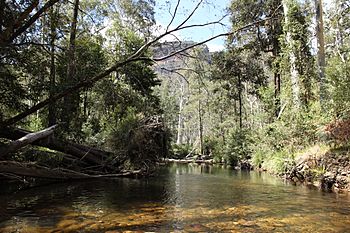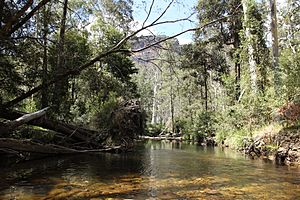Grose River facts for kids
Quick facts for kids Grose |
|
|---|---|

Grose River, near Blue Gum Forest, 2012
|
|
| Country | Australia |
| State | New South Wales |
| Region | Sydney Basin (IBRA), Blue Mountains |
| Local government areas | Blue Mountains, Hawkesbury |
| Physical characteristics | |
| Main source | Blue Mountains Mount Victoria 953 m (3,127 ft) 33°35′38″S 150°15′43″E / 33.593852°S 150.262018°E |
| River mouth | confluence with Hawkesbury River west of Agnes Banks 2 m (6 ft 7 in) 33°36′34″S 150°42′00″E / 33.609446°S 150.699969°E |
| Length | 54 km (34 mi) |
| Basin features | |
| River system | Hawkesbury-Nepean catchment |
| Tributaries |
|
| Valley | Grose |
The Grose River is a beautiful river that flows all year round in the Blue Mountains region of New South Wales, Australia. It's part of a bigger river system called the Hawkesbury-Nepean catchment.
Contents
Discover the Grose River's Journey
The Grose River starts its journey northeast of Mount Victoria. It flows through the amazing Blue Mountains National Park and the Grose Valley. This area is even part of a World Heritage Site, which means it's super important globally!
The river winds its way north, then southeast, and finally east. Along the way, four smaller streams, called tributaries, join it. These include Burralow Creek, Wentworth Creek, Govetts Creek, and Linden Creek. The Grose River then meets the Hawkesbury River near Agnes Banks.
Over its total length of 54-kilometre (34 mi), the river drops about 952 metres (3,123 ft) in height. That's a huge drop from its start in the mountains to where it joins the Hawkesbury River!
Explore the River: Bushwalking Fun

One of the best ways to see the Grose River, especially higher up, is by bushwalking. There are many well-kept walking trails that follow the river valley, offering stunning views.
A very popular walk leads to the Blue Gum Forest. This special place is where the Grose River and Govetts Creek meet. It's a fantastic spot for nature lovers!
How the Grose River Got Its Name
The Grose River was named in September 1793. It was named after Lieutenant Governor Francis Grose, an important figure in early Australian history.
Protecting the Grose River Area
The Grose River area is mostly protected as part of the Blue Mountains National Park. More than 80% of the land around the river is a protected area. This means it's kept safe for nature and for people to enjoy.
Because of this protection, the Grose Valley has stayed mostly untouched. Most of the human activity, like towns and industries, is kept away on the ridges around the valley. This helps keep the river and its surroundings clean and healthy.
The area also has many important Aboriginal sites and relics. These help us understand how Aboriginal people lived on the sandstone plateaus around Sydney a long time ago.
Discover the Grose Valley
The Grose Valley is a wild and rugged valley created by the Grose River. It's located between two main roads that cross the Blue Mountains: the Great Western Highway and Bells Line of Road. Most of this valley is part of the Blue Mountains National Park.
The valley is a favorite spot for bushwalking and has huge areas of untouched wilderness. The river flows through this natural environment for almost its entire length, making it a truly wild river. Its main tributaries, like Wentworth Creek, are also very wild.
Amazing Animals of the Grose Valley
The Grose Valley is home to many interesting animals. You might even spot a platypus in the river!
Certain swampy areas in the valley are home to the endangered Blue Mountains water skink (Eulamprus leuraensis). This special lizard is found only in the Blue Mountains.
The rocky sandstone areas provide homes for other unique and rare animals. These include the broad-headed snake (Hoplocephalus bungaroides).
In the woodland areas, you might see mammals like the red-necked swamp wallaby, the brush-tailed rock wallaby, and the tiny eastern pygmy possum.

